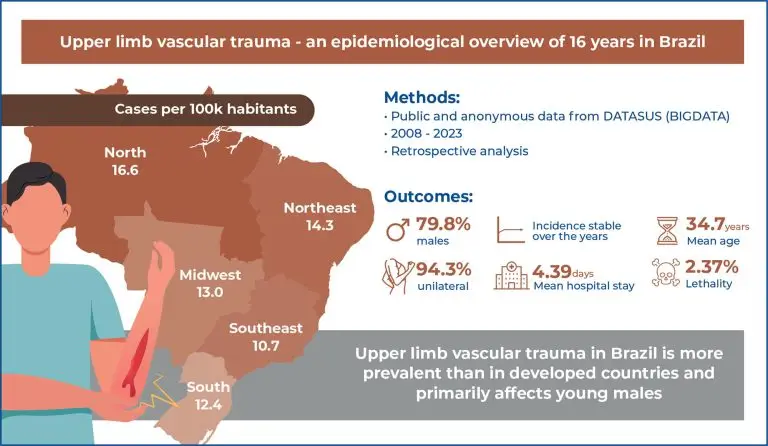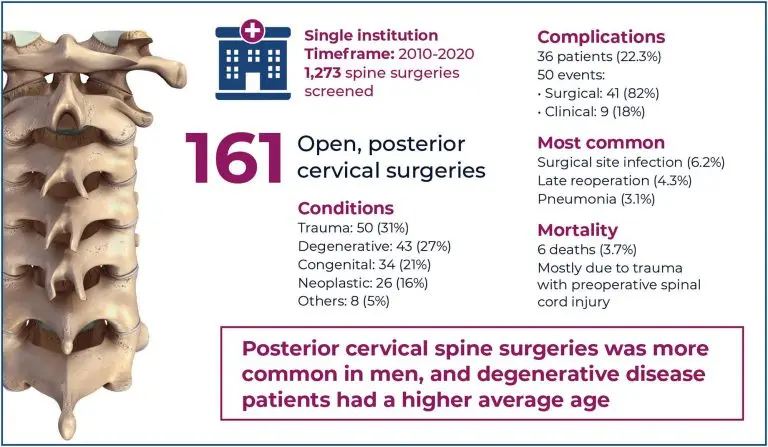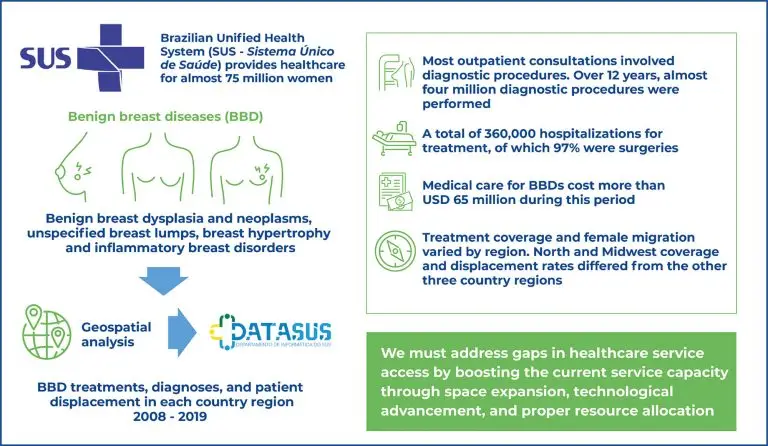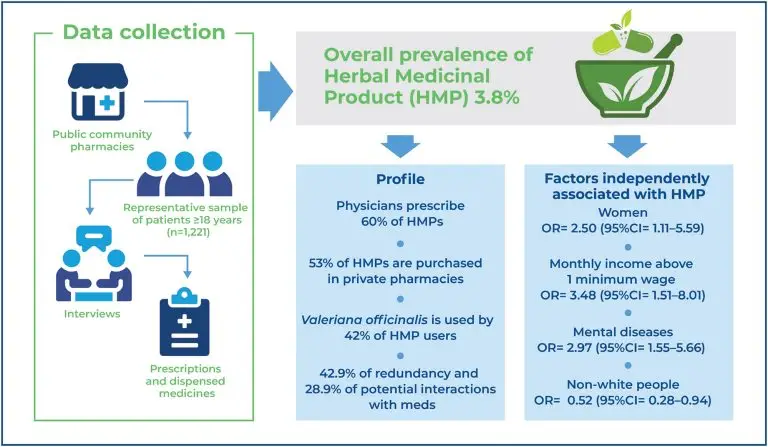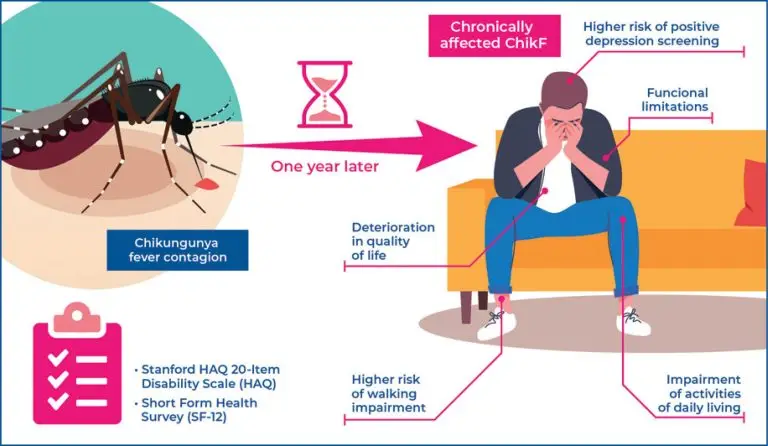31/out/2025
Determinants of invasive ventilation in infants with acute bronchiolitis: an observational study of pre-hospital and in-hospital treatments
DOI: 10.31744/einstein_journal/2025AO1512
Highlights ■ This single-center study evaluated the frequency and factors associated with invasive ventilation in infants with acute viral bronchiolitis on a pediatric ward. ■ The study revealed an invasive ventilation rate of 6%, associated with age, presence of atelectasis, and Wood-Downes-Ferres score at admission. ■ Many interventions with poor scientific evidence were used. ■ This study highlights the need to implement clinical protocols for the management of acute viral bronchiolitis, including all levels of care, as these infants are […]
Palavras-chave: Bronquiolite; Bronchodilator agents; Child; Epidemiologia; Hospitalização; Recém-nascido; Intubação intratraqueal/instrumentação; Pulmonary atelectasis
23/out/2025
Snakebites by Bothrops taeniatus: characteristics of snakebites involving a rare venomous snake in Brazil
DOI: 10.31744/einstein_journal/2025RC1430
ABSTRACT Snakebites from the genus Bothrops account for up to 90% of venomous snakebites in Brazil. Among these species, Bothrops taeniatus is considered rare in Brazil, with only one reported case in the literature. Its venom has a strong hemorrhagic effect but lacks procoagulant activity, which can lead to significant variations in the neutralizing efficacy of anti-Bothrops serum. We describe the first case of severe envenomation by B. taeniatus with rapid recovery following the administration of anti-Bothrops serum in Brazil, […]
Palavras-chave: Antivenins; Bothrops taeniatus; Epidemiologia; Snake bites; Snake venoms
03/out/2025
Nationwide epidemiological analysis of surgically treated upper limb vascular trauma over 16 years in Brazil
einstein (São Paulo). 03/out/2025;23:eAO1339.
Ver Artigo03/out/2025
Nationwide epidemiological analysis of surgically treated upper limb vascular trauma over 16 years in Brazil
DOI: 10.31744/einstein_journal/2025AO1339
Highlights ■ Brazil had a higher upper limb vascular trauma incidence than the US, remaining stable over the years. ■ The region with the highest proportion of cases was the North, followed by the Southeast. ■ The most affected population was young men, with a lethality of 2.37%, comparable to that globally. ■ Most patients did not require intensive care (92.8%), and the average hospital stay was 4.39 days. ABSTRACT Objective: To evaluate the epidemiology of upper limb vascular trauma […]
Palavras-chave: Brasil; Data mining; Epidemiologia; Health Information System; Incidence; Upper extremity; Vascular injury
11/set/2025
Posterior cervical spine surgery epidemiology and complications: a large retrospective case series
DOI: 10.31744/einstein_journal/2025AO1830
Highlights ■ Posterior cervical spine surgery showed an overall complication rate of 22.3%, mainly surgery-related. ■ Surgical site infection (6.2%) and late reoperation (4.3%) were the most common complications. ■ The average patient age varied by etiology, being the lowest in neoplastic cases (34.4 years) and the highest in degenerative cases (55.7 years). ■ No statistically significant associations were found between complications and patient characteristics, except for a trend toward more complications in urgent surgeries (p=0.085). ■ Mortality was 3.7%, […]
Palavras-chave: Cervical spine; Epidemiologia; Complicações pós-operatórias; Procedimentos cirúrgicos
28/mar/2025
Brazil’s benign breast disease care profile and geospatial analysis
DOI: 10.31744/einstein_journal/2025AO1132
Highlights ■ Most outpatient consultations comprised diagnostic procedures. ■ In the past 12 years, medical care for benign breast diseases has cost >USD 65 million. ■ Women from North and Midwest Brazil had higher diagnosis and treatment displacement rates. ABSTRACT Objective: To quantitatively and geospatially analyze coverage and displacement for the diagnosis and treatment of benign breast diseases in the Brazilian Unified Health System between 2008 and 2019. Methods: Datasets from the Brazilian Ministry of Health were used to survey […]
Palavras-chave: Brasil; Breast diseases; Neoplasias da mama; Demography; Epidemiologia; Gastos em saúde; Custos de cuidados de saúde; Hospitalização; Incidence; Primary healthcare; Saúde pública; Strategy planning; Sistema Único de Saúde
21/out/2024
Use of herbal medicinal products among patients in primary health care in a Brazilian southeastern city: evidence from the Prover project
einstein (São Paulo). 21/out/2024;22:eAO0827.
Ver Artigo21/out/2024
Use of herbal medicinal products among patients in primary health care in a Brazilian southeastern city: evidence from the Prover project
DOI: 10.31744/einstein_journal/2024AO0827
Highlights Herbal medicinal product use was 3.8%, with high formal prescription; however, it is accompanied by a high risk of interactions and redundancy. Unified Health System pharmacies are not the main source of herbal medicinal products, suggesting low service implementation. Women, people with mental disorders, and allopathy simultaneously users should receive attention. Non-white people are less likely to use herbal medicinal product, suggesting inequalities in accessing these treatments. ABSTRACT Objective: To determine the prevalence and factors associated with herbal medicinal […]
Palavras-chave: Brasil; Epidemiologia; Phytotherapy; Plantas medicinais; Atenção Primária à Saúde; Retardo do crescimento fetal
20/set/2024
Impact of chronic illness caused by chikungunya fever on quality of life and functionality
DOI: 10.31744/einstein_journal/2024AO0562
ABSTRACT In Brief Chikungunya fever compromises the functionality and quality of life in the affected individuals, even one year after the acute phase of the disease. Chronically affected people experience direct impairment in performing daily activities, along with a risk of developing other morbidities. Highlights Even after a year, chikungunya fever-affected people experience damage to their physical and mental health. Positive screening for depression risk was 13.5 times more likely in chronically affected. Patients with chronic chikungunya fever had a […]
Palavras-chave: Chikungunya fever; Epidemiologia; Dor; Qualidade de vida
11/abr/2024
Analysis of signs and symptoms in confirmed cases of severe dengue among children aged 0 to 10 years old
DOI: 10.31744/einstein_journal/2024AO0546
Highlights The average age was 4.34±2.56 years. Highest prevalence in Brown and White races. Highest prevalence rate was found in the Southeast, followed by the Central-West and South. The majority of analyzed cases progressed to hospitalization. Prevalent respiratory failure, hematemesis, and melena are associated with both. Prevalence of changes in the level of consciousness, which is important at the central nervous system level. ABSTRACT Objective: The prevalent symptoms of severe dengue in pediatric patients are divided into three subgroups: severe […]
Palavras-chave: Brasil; Child; Dengue; Epidemiologia; Comorbidade
Association of moderate and vigorous physical activity and relative muscle strength with neck circumference: a cross-sectional analysis of the Study of Health in Pomerode (SHIP-Brazil)
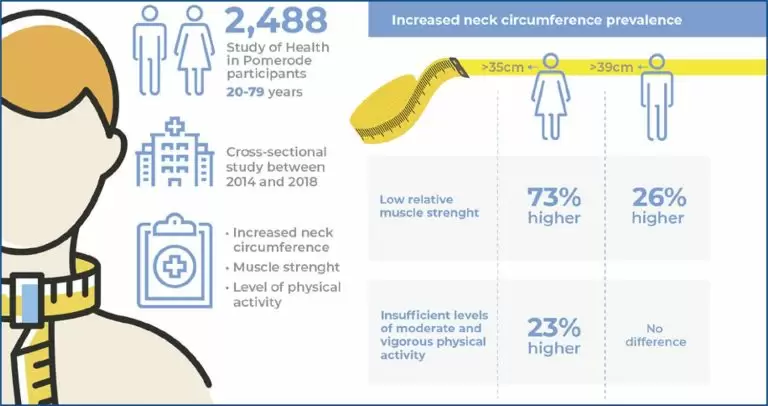
23/maio/2023
Association of moderate and vigorous physical activity and relative muscle strength with neck circumference: a cross-sectional analysis of the Study of Health in Pomerode (SHIP-Brazil)
einstein (São Paulo). 23/maio/2023;21:eAO0186.
Ver Artigo23/maio/2023
Association of moderate and vigorous physical activity and relative muscle strength with neck circumference: a cross-sectional analysis of the Study of Health in Pomerode (SHIP-Brazil)
DOI: 10.31744/einstein_journal/2023AO0186
Highlights Neck circumference can be used in clinical evaluation for health monitoring. The prevalence of increased neck circumference is high and is associated with relative muscular strength in men and level of moderate and vigorous physical activity and relative muscular strength in women. Neck circumference is an important predictor of low moderate and vigorous physical activity and relative muscular strength in men, and the results are more pronounced in adult and older adult women. We suggest implementing exercise programs to […]
Palavras-chave: Antropometria; Epidemiologia; Exercício; Hand strength; Measurement; Pescoço; Retardo do crescimento fetal; Comportamento sedentário
30/mar/2023
Relationship between microcephaly and indicators of social inequality in the state of Paraíba, Brazil
einstein (São Paulo). 30/mar/2023;21:eAO0043.
Ver Artigo30/mar/2023
Relationship between microcephaly and indicators of social inequality in the state of Paraíba, Brazil
DOI: 10.31744/einstein_journal/2023AO0043
Highlights Seventy-four (33.18%) municipalities in the state of Paraíba registered live births with microcephaly. The highest proportion of cases (23.03%) was concentrated in the capital, João Pessoa. Number of inhabitants, number of cases of Zika virus, water supply, and average household income were associated with a higher proportion of new cases. ABSTRACT Objective To analyze the relationship between microcephaly and social inequality indicators in the state of Paraíba during the biennium January 2015 and December 2016. Methods Ecological study with […]
Palavras-chave: Epidemiologia; Gender equity; Health inequities; Health information systems; Microcephaly; Social determinants of health; Social indicators; Zika virus; Zika virus infection





